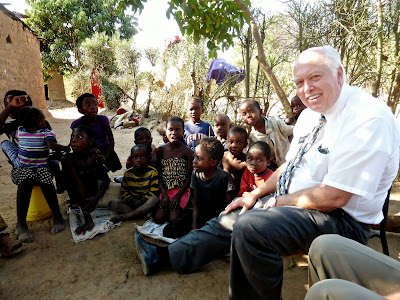The Copperbelt is an area on the northern left lobe of Zambia. It is also the name of the district or "state" that comprises that area of natural copper resources. The DRC or Democratic Republic of the Congo is that little chunk that seems to split Zambia that is also full of copper and the Zambians lost it to the northern country, not with fighting but with politics, many years ago. The area is Zambia's greatest source of wealth. Zambia is always complaining about the natural resources being exploited by other countries and not staying in Zambia.
The mission president sent us up to the Copperbelt for a visit. It is one third of our mission, so it was nice to be able to see what everyone was talking about and what the flats or apartments looked like that I paid the rents on.
These are some of the photos I took on this four day tour.
First of all, Lusaka beer heading north. Those are not milk cartons but containers of beer.
Once out of the city, life is VERY rural.
The small town market places look much like the big city markets.
This is a typical city outside the capital. This is Kabwe's main street.
Along the paved highway are vendors. Here was an area that specialized in gourds. Charcoal and fruit and vegetables are the most common.
The termite mounds are everywhere but different species build them higher. Some are quite impressive.
We stayed in a flat that the mission just leased for visitors. It is located next to the sisters' flat and has a guard at night. It was brand new so it was surprising to see the quality of workmanship. You can see in this photo the light coming in alongside the panel and under the door. It was actually much worse than the photo.
There was a Zone meeting while we were there so we got in our first photo with missionaries after four months. It is so nice to be able to be around the missionaries and feel of their energy and spirit.
We hung out with a senior couple who live in the Copperbelt, the Harveys.
They showed us around town and the location of the various churches and missionary flats.
Here, they took us to a village called Kawama. It was like a step back in time.
This is a common site. It is a game that is played a little like mancela. The holes are to be found in most yards where folks sit on the ground and play moving stones from one "cup" to another very quickly.
We were introduced to the Primary President and then a lot of children gathered and Sister Harvey related a story to them. They were enthralled with her story telling and our visit.
We had to have our photo taken and wouldn't have if I thought they would be the least offended but everyone seemed to enjoy it.
This is the Harveys' last week in Zambia and I am sure they are having a difficult time saying goodbye to their many friends.
I am always fascinated with what women need to clean and what can be let go.
Elder Harvey was having a chat with the father of the family.
I just liked the next few photo that look representative of what goes on outside the big city.
These kids loved holding Elder Harvey's hands on the way out. They kept feeling his hairy arms.
He looks like the Pied Piper.
Everyone was so friendly. The parasols were coming out as the temperature was heating up.
This roadside stand was just northwest of Ndola. It is the first time I have seen an abundance of art work displayed. I would have liked to stop and chat about the materials they used and where they got it.
These are rugs made from rags and tied together.
We saw lots of evidence of mining in the north. There are many open pit copper mines and slag heaps from the smelters. We followed this truck on the way south again. He is carrying big ingots of raw copper, the wealth of Zambia.





















